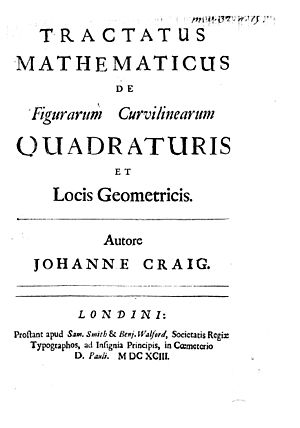John Craig (mathematician) facts for kids
Quick facts for kids
John Craig
|
|
|---|---|
| Born | 1663 |
| Died | 11 October 1731 |
| Nationality | Scottish |
| Alma mater | University of Edinburgh |
| Known for | Log-likelihood ratio |
| Scientific career | |
| Fields | Mathematician |
| Academic advisors | David Gregory |
| Influences | Isaac Newton |
John Craig (born in 1663 – died on October 11, 1731) was a Scottish mathematician and theologian. This means he was an expert in both math and religious studies.
Contents
About John Craig
John Craig was born in Dumfries, Scotland. He studied at the University of Edinburgh. Later, he moved to England. There, he became a vicar, which is a type of priest in the Church of England.
He was a good friend of the famous scientist Isaac Newton. Craig wrote several smaller books about a new type of math called calculus.
In 1711, he was chosen to be a Fellow of the Royal Society. This is a very important group for scientists in the United Kingdom.
His Book on Christian Theology
John Craig is well-known for his book called Theologiae Christianae Principia Mathematica. This means Mathematical Principles of Christian Theology. He published it in 1698.
In this book, Craig tried to use a formula to describe how likely a historical event was. He thought about how the chance of a story being true changes over time. He looked at how many people first saw the event. He also considered how the story was passed down through others.
Using his formula, Craig calculated that the story of Jesus would become zero percent likely by the year 3150. He believed this year might be when Jesus would return, based on a verse in the Gospel of Luke.
Many people at the time did not like his ideas. They thought his math was not exact. They also felt his formula was not proven.
Working with Logarithms
John Craig also helped to develop the idea of Hyperbolic logarithms. These are a special type of logarithm used in math.
In 1710, he published a paper called “Logarithmotechnica generalis.” This paper appeared in the Proceedings of the Royal Society. In it, he showed how to calculate logarithms using a specific math series.
His Published Works
Here are some of the works John Craig published:
- 1698: Logarithmic quadrature (in Latin) Philosophical Transactions of the Royal Society
- 1703: Specimen of determining quadrature of figures (in Latin), Philosophical Transactions of the Royal Society #284 via Biodiversity Heritage Library
- 1710: Method of making logarithms (in Latin), Philosophical Transactions of the Royal Society


